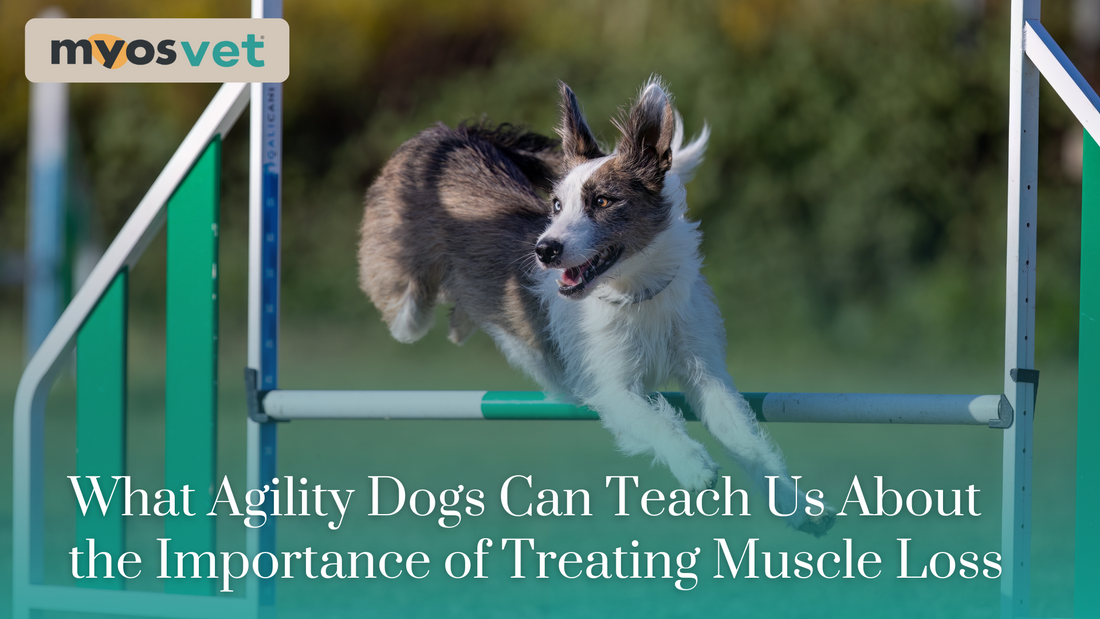
What Agility Dogs Can Teach Us About the Importance of Treating Muscle Loss
Share
If you have ever watched an agility competition, you know the sheer athleticism these dogs bring to the arena. Their speed, precision, and incredible coordination are awe-inspiring. But behind every jump, weave, and tunnel run is a muscular system working at its peak—and a conditioning regimen that keeps it that way.
Agility dogs offer more than entertainment. They give veterinarians a valuable lens through which to understand the critical importance of muscle health—and what happens when it starts to decline.
Muscle Health: A Performance Indicator and a Lifeline
Agility dogs rely heavily on lean muscle mass for explosive energy and stability. In this population, even minor muscle loss can result in slower run times, poor recovery, or increased injury risk. While their high-performance lifestyle puts their muscle health front and center, muscle loss is not unique to working or sporting dogs. It's a common and often under-diagnosed issue in the general canine population—especially in aging pets or those recovering from injury or illness.
Loss of muscle mass, also known as sarcopenia, can have a profound effect on a dog’s mobility, metabolism, immune function, and overall quality of life. As agility handlers and trainers are acutely aware, prevention and early intervention are key. So why should we approach our everyday patients any differently?
What Happens When Muscle Loss Goes Untreated?
Agility dogs who experience muscle atrophy may struggle to clear jumps, lose their competitive edge, or suffer from repetitive strain injuries due to imbalances. Similarly, muscle loss in companion dogs can lead to:
- Decreased mobility and endurance
- Joint instability
- Increased risk of falls or further injury
- Longer recovery times post-surgery or illness
- Reduced metabolic and immune function
When we delay addressing muscle atrophy, especially in aging or sedentary patients, we risk allowing a downward spiral in physical health that can be difficult to reverse.
MYOS Canine Muscle Formula: A Nutritional Approach to Muscle Support
For veterinarians looking to proactively support canine muscle health, MYOS Canine Muscle Formula offers a unique nutritional solution. Made with a single, all-natural ingredient—Fortetropin®, a bioactive composition derived from fertilized egg yolk—this formula is used to help maintain and build muscle in dogs of all ages.
Agility trainers have recognized the importance of targeted muscle support, and some are now integrating MYOS Canine Muscle Formula into their conditioning protocols to keep dogs strong and resilient. But the benefits extend far beyond competition. Companion animals recovering from orthopedic surgery, senior pets with age-related muscle decline, and dogs dealing with chronic conditions like osteoarthritis may also benefit from nutritional muscle support.
A Paradigm Shift in Veterinary Practice
Agility dogs show us the power of proactive care and performance-driven conditioning. By adopting some of the same principles—monitoring muscle mass, tailoring nutrition, and intervening early—we can improve outcomes for a wide range of patients.
Veterinarians are uniquely positioned to lead this shift. Start with routine muscle assessments during wellness exams. Educate pet parents on the signs of muscle loss. And consider integrating muscle-supportive nutrition, like MYOS Canine Muscle Formula, into treatment plans for aging, post-op, or mobility-compromised dogs.
Because whether a dog is running agility courses or just trying to get up the stairs, muscle matters.
